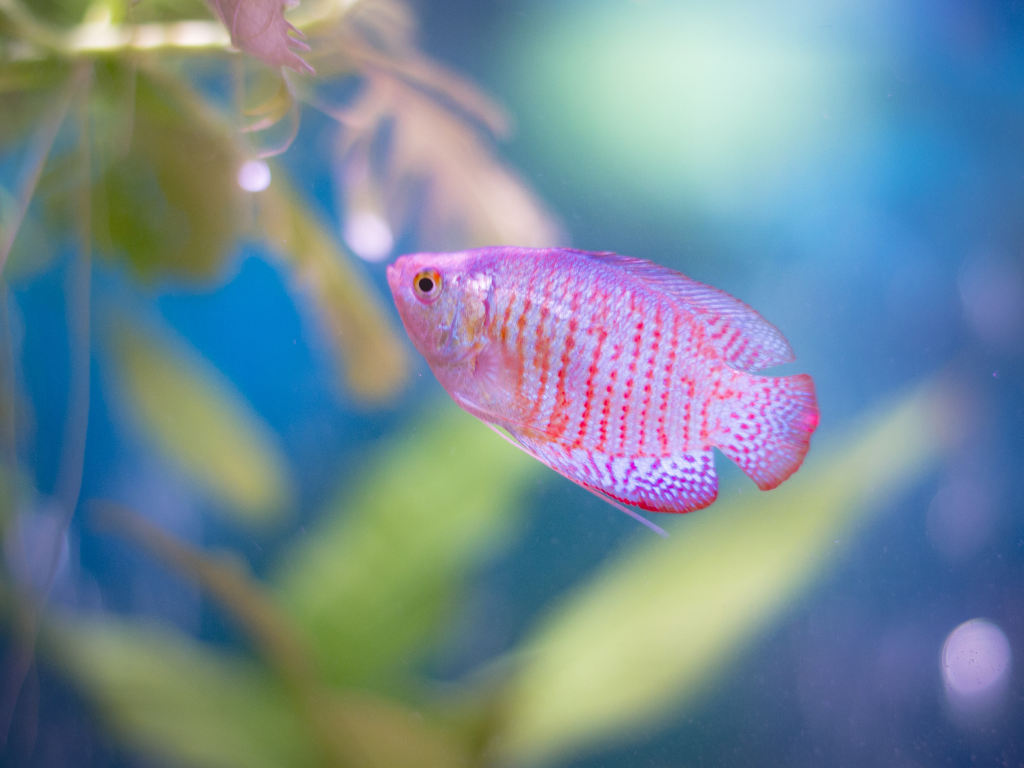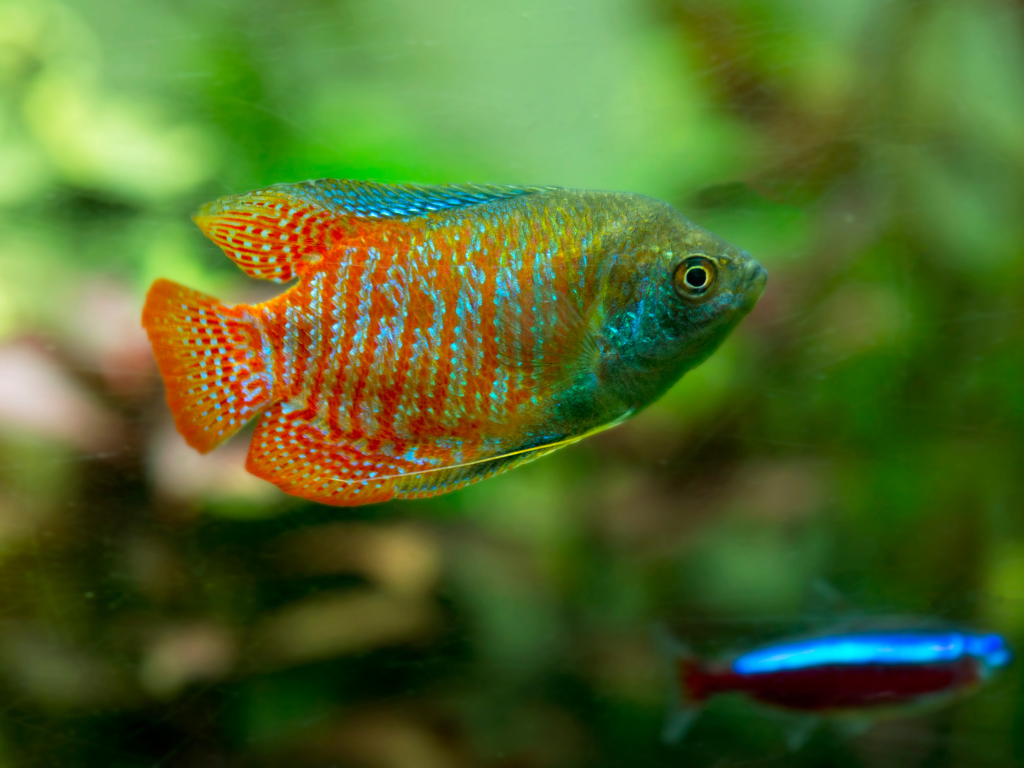Dwarf Gourami 101: Care, Diet, Tank Size, Tank Mates, & More

- Overview of the Dwarf Gourami
- Tank Size Requirements for Dwarf Gourami
- Choosing Compatible Tank Mates
- Water Conditions for Dwarf Gourami
- Essential Tank Setup for Dwarf Gourami
- Diet and Feeding Habits
- Lifespan and Health Concerns
- Understanding Dwarf Gourami Appearance
- Behavior and Social Interaction
- Breeding Dwarf Gourami
- Differences Between Male and Female Dwarf Gourami
- Fun Facts About Dwarf Gourami
Are you thinking of adding a splash of color and a touch of elegance to your aquarium? The Dwarf Gourami may be the perfect choice. This charming fish, known for its vibrant hues and unique behavior, can bring life to any aquatic environment.
But before you dive in, let’s explore everything you need to know to keep this mesmerizing species healthy and thriving.
Overview of the Dwarf Gourami
The Dwarf Gourami (Trichogaster lalius) is a popular freshwater fish that appeals to both novice and experienced aquarists alike. Originating from the warm waters of South Asia, particularly in Pakistan, northern India, and Bangladesh, this species thrives in slow-moving waters like swamps and ponds.
These fish are often found in heavily vegetated areas, which provide them with natural cover and breeding grounds.

In addition to their native range, Dwarf Gouramis have established feral populations in countries like Singapore, the USA, and Colombia. Their adaptability to varied water quality, from acidic to alkaline, makes them a robust choice for home aquariums.
One of the fascinating features of the Dwarf Gourami is its labyrinth organ, which allows it to breathe atmospheric oxygen. This adaptation is crucial for survival in low-oxygen environments, enabling these fish to gulp air from the surface, particularly in polluted or shallow waters.
Tank Size Requirements for Dwarf Gourami
Choosing the right tank size is essential for maintaining a healthy environment for Dwarf Gouramis. While they are relatively small fish, their social behavior necessitates adequate space.
- A minimum tank size of 15 gallons is recommended to allow for adequate swimming space.
- Dimensions of at least 24 inches in length and 12 inches in width are ideal.
- A larger tank can help reduce aggression and territorial disputes, particularly among males.
When keeping multiple Dwarf Gouramis, ensure the tank is spacious enough to accommodate their social interactions without causing stress or aggression.
Choosing Compatible Tank Mates
Dwarf Gouramis are known for their peaceful nature, making them suitable companions in community aquariums. However, careful selection of tank mates is crucial to ensure a harmonious environment.
- Avoid aggressive fish species that may bully or injure the Gouramis.
- Flashy fish with long fins, such as Bettas and Guppies, should also be avoided, as Dwarf Gouramis may nip at them.
- Good tank mates include Barbs, Plecos, Rasboras, and Neon Tetras, as they coexist well with Dwarf Gouramis.
It's essential to introduce new tank mates gradually and monitor their interactions closely. Providing plenty of hiding spots and plants can help reduce stress among fish.
Water Conditions for Dwarf Gourami
Maintaining the right water parameters is crucial for the health of Dwarf Gouramis. These fish are relatively hardy but thrive in optimal conditions.
- Temperature: 71 to 82°F (22 to 28°C) is ideal for Dwarf Gouramis.
- pH level should be maintained between 6.6 and 7.4.
- Water hardness should range from 5 to 19 dGH.
Regular water testing and routine maintenance, including partial water changes, will help keep these parameters stable.
Using a good quality filtration system is recommended, but ensure that the water flow is gentle, as Dwarf Gouramis prefer calm waters.
Essential Tank Setup for Dwarf Gourami
Setting up a suitable tank environment is vital for the well-being of your Dwarf Gourami. While they can adapt to various setups, certain features enhance their habitat.
- **Heater**: Essential for maintaining a stable temperature.
- **Filter**: A low-flow filtration system is preferable.
- **Substrate**: Use a dark, sandy substrate to highlight their vibrant colors.
- **Decorations**: Incorporate plants, driftwood, and rocks to create hiding spots and territories.
A well-planted aquarium not only provides shelter but also mimics their natural habitat. Leave open swimming areas to allow for active movement.
Diet and Feeding Habits
Dwarf Gouramis are omnivorous, with a preference for protein-rich foods. In the wild, their diet consists of a variety of organisms, including:
- Rotifers
- Crustaceans
- Worms
- Small algae
In captivity, they will accept a wide range of foods. A balanced diet should include high-quality flakes or pellets, supplemented with live or frozen foods such as bloodworms, brine shrimp, and daphnia.
Regular feeding times should be established to prevent overfeeding, as Dwarf Gouramis are known to be voracious eaters.
Lifespan and Health Concerns
With proper care, Dwarf Gouramis can live up to six years, although the average lifespan is around four years. In the wild, their lifespan is typically shorter due to predation and environmental stressors.
To promote longevity, maintain clean water conditions, and provide a varied diet. Regularly inspect your fish for signs of stress or illness, such as changes in behavior or appearance.
Understanding Dwarf Gourami Appearance

Dwarf Gouramis are characterized by their striking coloration and distinctive body shape. They have a robust body with a slightly protruding head and a small mouth. Their vibrant colors can vary, but they typically display:
- Blue and red/orange stripes
- Reddish-brown lines in wild specimens
- Large, closely positioned scales
These visual traits make them a standout species in any aquarium, often sought after by aquarists for their beauty.
Dwarf Gouramis are active and curious, often exploring all levels of the aquarium. They tend to occupy the middle and upper regions, where they feel safest. Upon introduction to a new tank, they may initially exhibit shyness, but will become more active as they acclimate.
Observing their behavior can be fascinating, as they interact with their environment and other fish. However, ensure they have sufficient hiding spaces, as they can become stressed if they feel threatened.
Breeding Dwarf Gourami
Breeding Dwarf Gouramis is relatively straightforward and can occur in home aquariums. This species is oviparous; females lay eggs in a bubble nest created by males. The breeding process is influenced by environmental changes, such as flooding conditions.
During breeding, the male may exhibit aggressive behavior towards the female until the mating ritual begins. The spawning usually involves the male wrapping around the female to release eggs, which he then collects and places in the nest. The male guards the nest until the eggs hatch, usually within 36 hours.
Differences Between Male and Female Dwarf Gourami
Sexual dimorphism is evident in Dwarf Gouramis. Males tend to be larger and more vibrantly colored than females. Additionally, males have elongated dorsal and anal fins, while females are typically silver and have shorter fins. This distinction is important for aquarists who wish to maintain balanced breeding pairs.
Fun Facts About Dwarf Gourami
- These fish are favored by aquarists for their beauty and hardiness.
- Dwarf Gouramis thrive in stagnant waters rich in vegetation, which provides natural cover.
- They possess a labyrinth organ that allows them to breathe air, making them well-suited for low-oxygen environments.
For more insights into Dwarf Gourami care, check out this informative video:
Reference: The Nerdy Fish Girl
By understanding the needs and characteristics of the Dwarf Gourami, you can create an ideal environment for these captivating fish, ensuring they thrive and bring joy to your aquarium. With the right care, they can be a stunning addition to your aquatic collection.

Leave a Reply